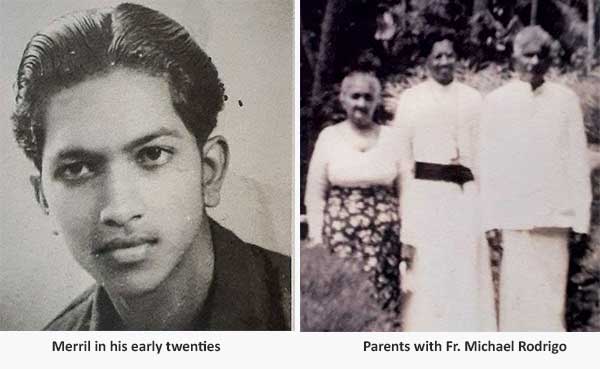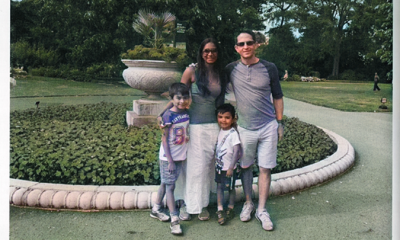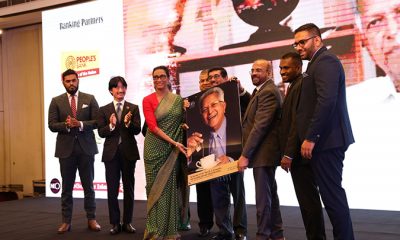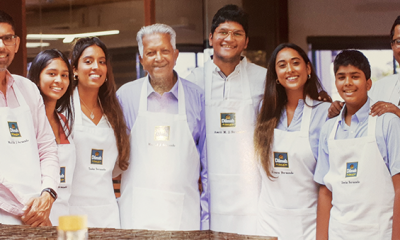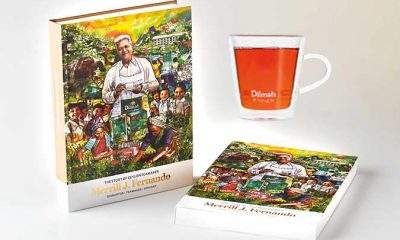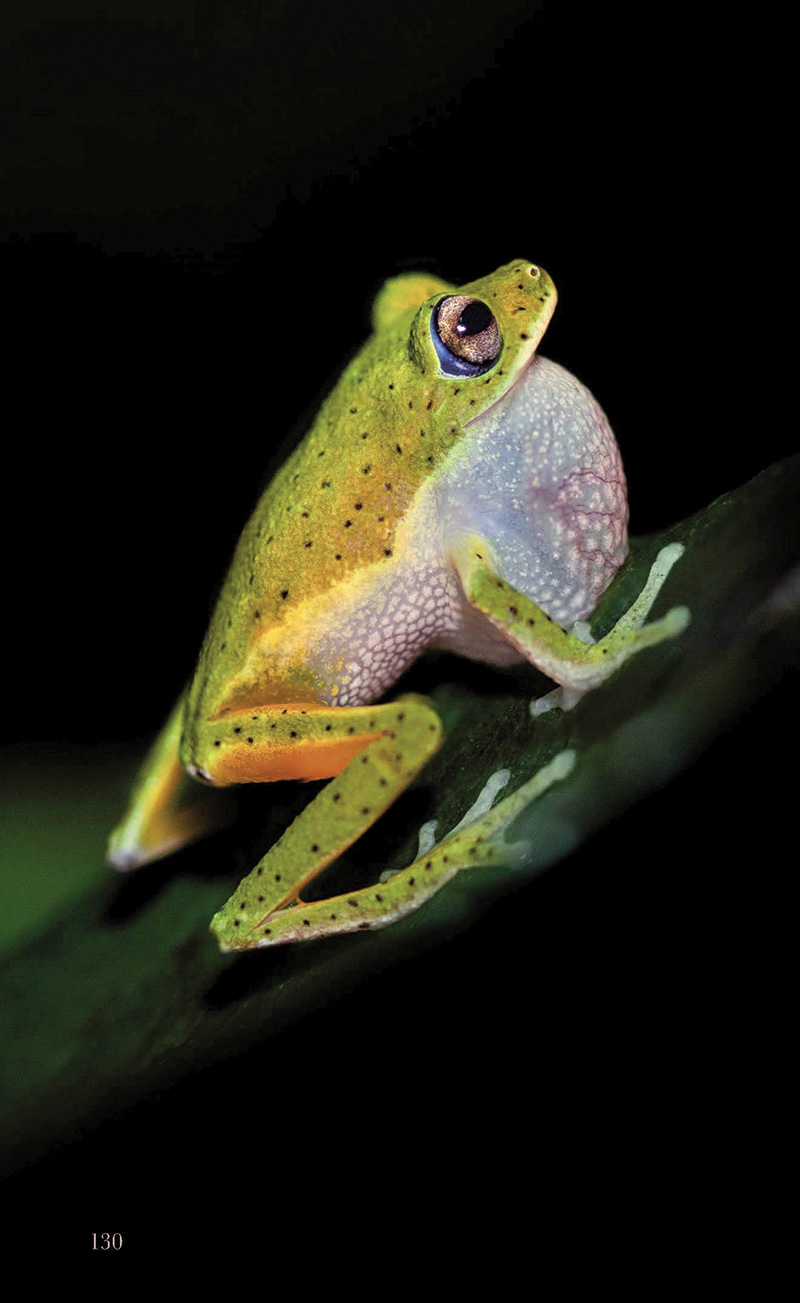Features
My beginnings at Pallansena and how my parents and the village influenced my life

The Merril. J Fernando autobiography
Excerpted from The Story of the Ceylon Teamaker
Ninety-three years ago – in 1930 – I was born to a middle class family in the village of Pallansena, as the youngest of the six children of Harry and Lucy Fernando. My sister, Agnes, was the eldest and then came brothers Lennie and Pius, followed by sisters Doreen and Rita. My family roots can be traced back to this village where, from the time of my great-grandparents, ours had been a leading family.
Pallansena is situated about 15 kilometres north of the Colombo International Airport. Many decades ago, long before the airport was even thought of, it was a small village of about 100 closely-knit families. As common to such villages then, most of the families were connected to each other, either through blood or marriage. Irrespective of such connections, all those who lived in the village comprised one large family, held together by religious and cultural commonalities, shared responsibilities, and concern for one another.
Pallansena is no longer a village though, having gradually been overwhelmed by the urbanization and commercialization that is changing the charming landscape of this country, all over. That once-serene rural community is now a crowded suburb of the more densely-populated Kochchikade. The land on either side of the road that I, as a child, used to walk along on my way to the Pallansena village school, was lined with coconut plantations. Today, only a few scattered patches of coconut remain.
Much of the old plantation land is now built over, with modern residences, shops, hotels, and guest houses. In the village of Pallansena itself, most of the graceful old houses with wide verandahs and central courtyards, set deep in large, tree-laden gardens, have disappeared. Instead, unlovely facades of brick, glass, and concrete with barred windows line the roads on both sides.
Many of the houses then, large and small, had intricate wooden trellis frontages, which gave privacy but did not hinder ventilation. These have now been replaced by featureless iron and masonry grills. The very few old houses that remain still evoke memories of a vanished appeal. However, unlike in my youth, they too are now surrounded by high parapet walls and, therefore, rarely seen.
The Maha Oya and the Hamilton Canal which flows into it, in my youth clearly visible through the trees, and the houses which lined the gravel road running past the Our Lady of Seven Sorrows Church, have been obscured by row upon row of buildings. The once-pristine surface of the water and the clean, sandy banks, lined with rushes and other water plants, are today littered with imperishable plastic debris.
Instead of the weathered, light wooden canoes and rafts which used to be drawn up on the banks, far apart from each other, hundreds of garishly-coloured fibre-glass motor boats are anchored, shoulder to shoulder and bow to stern, at the edge of the water. The muted splash of wooden oars has been replaced by the clatter of high-powered outboard motors, rudely cleaving the surface. The broad-beamed padda boats with sloping cadjan canopies, steered by weather-beaten boatmen wielding long wooden poles, transporting both cargo and people, were another common feature along the canal in my early youth. They too disappeared many decades ago.
In my youth the community co-existed in gentle harmony with its surroundings. But, today, the unforgiving influence of commercial prosperity has been imposed on a once-tranquil society. Signs of affluence are visible and numerous, but they have come at a heavy price, which has been paid by a vulnerable environment.
Formative influences
Pallansena, like most villages on the western coast then, especially north of Colombo, was almost entirely Catholic, the result of the Portuguese influence, which first made its presence felt in Ceylon at the beginning of the 16th century. Religion was both a powerful unifying and guiding force and all families were raised on the strict spiritual principles of the faith. The Parish Priest was a man of great authority in the community, a sort of a benevolent dictator, a feature common to all such societies.
The village church used to be the centre of both religious and social activity. As a youth I was an altar boy in the church, then considered a proud distinction. Despite the many developments that have changed the face of Pallansena over the years, the church continues to be a powerful influence in the community. In a society which has evolved almost beyond recognition, that one feature has remained a constant in the nine decades since my birth.
My parents, especially my mother, raised me strictly according to sound, time-tested values, centred around the family and our faith. She was very religious and civic-minded and from my childhood, instilled in me the need to help our less-affluent neighbours. She visited other families regularly and, despite my vocal protests, quite often shared with the children of these families the prized goodies that I received, such as cakes, chocolates, and sweets.
In that era, in communities such as Pallansena, whilst there was no significant poverty, there were still a few underprivileged families. To my mother, helping such people was a serious moral obligation. She was a woman of great generosity and humility and was truly loved by the people of the village. She is still spoken of with much affection and gratitude by the older folk of the village, especially those who benefited from her compassion.
Neighbours reciprocated my mother’s many acts of kindness by frequently bringing her their home-grown fruits, vegetables, and traditional home-made sweets. As she sat in her verandah, always with rosary in hand, passing neighbours would stop and talk to her. They would also offer to buy her groceries and run other little errands for her. Sharing and caring were endearing features of our village, undoubtedly mirrored across many similar communities then, unlike in the highly-urbanized and commercialized age we live in now.
The principles that I still live by were articulated for me, very early, by role model example by my parents, especially my mother. They were conditioned largely by the teachings of my religion and the decent ethics of life, which are common to all great religions and principled societies. Since moving out of that somewhat-cloistered community and into the larger world of industry and international commerce eventually, I have been exposed constantly to different learnings and varied influences. However, the strength of that early indoctrination is such that I have remained true to those principles of conduct and interaction. On reflection, I feel comfortable with myself today because my basic values have not changed.
In the environment I was brought up, people took time and effort to care for each other. The concern that people of the village had for each other was clearly demonstrated, in times of both grief and joy. For example, when there was a funeral in the village, neighbours would send the mourning family meals for three days. Similarly, when there was a wedding, neighbours would send dinner to the wedding house on the pre-nuptial night. These traditions were of great practical benefit, intended to reduce pressure on the family concerned, enabling them to concentrate on the event.
For generations my ancestors had worshipped at the Pallansena, Our Lady of Seven Sorrows Church. My maternal great-grandparents, Petrus Perera and Anna Marie Perera, passing on in 1881 and 1901 respectively, are interred within the southern wing of the church, their final resting places marked by two stone tablets set into the church floor. Despite the many feet of worshippers which have trod on them for over a century, the dedications etched into the slabs are still very clear. Apparently, this unusual distinction had been extended to these two ancestors of mine, on account of their generosity to the church.
The spacious grounds on which the church now stands had been gifted by these two, whilst they had also contributed generously towards the construction of the church itself. The incumbent priest’s residence, a beautiful, heavily-timbered, two-storeyed, Dutch-styled house, still elegant despite some indelicate, subsequently introduced modern flourishes, had also been built by them.
They had both been well-reputed Ayurveda physicians, especially known for the treatment of cataract and other eye diseases. My grandmother and grand-aunts continued this healing tradition. I recall that there would be many patients consulting them every day, with the numbers increasing on weekends.
They also made a very special herbal oil which, apparently, was guaranteed to keep hair black, well into old age.
My brothers and sisters used that oil and retained black heads of hair, well into their seventies. I used it in my teens. It had a very strong, highly-aromatic scent, but in my view, not unpleasant. However, since my schoolmates objected to the smell, I stopped using it very early. This wonder oil was distilled from a mixture of rare herbs and ghee, all the ingredients being boiled together in copper cauldrons, over wood fires, for three weeks.
Sadly, none of our younger family members learned the formula for this healing oil. I still have a thick head of hair, but it has been silver for a long time. Perhaps, instead of yielding to my schoolmates, I should have continued to use the oil!
The medicines for the treatment of eye diseases were distilled from a variety of herbs, which were crushed and mixed with other ingredients, including mothers’ breast milk. Often, in my youth, I was frequently given the embarrassing assignment of approaching breast feeding mothers in the village and asking for spoonsful of milk. It was always readily given, though.
My grandmother was a heavily-built lady who spent most of her time in a comfortable chair, with her walking stick beside her. As a playful little boy, I used to tease her by hiding it frequently and my aunts had to retrieve it repeatedly, scolding me all the time. In her annoyance at my harassment she used to threaten me. It was then fun for me, but I realized later how irritating I would have been to her.
My two aunts were very religious, always praying to God for the welfare of the family. I would ask them if they were praying for me, too. The answer was always a very firm NO, because I used to annoy my grandmother all the time. No one knew my grandmother’s exact age, but she lived a comfortable life for over 100 years.
My parents
I truly miss the village life of my early youth, the transparently genuine values of simple people — kindness, cordiality, love, and concern for one another and especially the needy were the virtues that held such societies together. Those values are unknown in big cities today. I miss the fresh air, the clean rivers and canals, sea bathing, and the furtive swimming outings with friends of my age in the Maha Oya, which flowed behind my home. My pet dog, Beauty, a Golden Retriever, would also jump into the water with us and stay at my side as long as I was in the water. Such faithfulness is still seen amongst animals but rarely with people.
My mother was very protective of me and terrified of my swimming. She did not allow me to swim either in the river or the sea. Invariably, even on our secret swimming escapades, she would appear on the bank within minutes of us entering the water and scold my friends for having persuaded me to get in, although it was actually on my invitation that we were in the water. My friends were always in awe of my mother. Despite her naturally kindly nature, when angry she could be formidable.
On weekends I used to get together with a few of the village boys and play cricket, football and ‘elle’ on the road. The latter game, a simplified version of American baseball, would attract others from the village and soon we would have as many as 20 people competing. It was great fun, with the winners eventually treating the losers with king coconut plucked from a nearby tree.
Those were wonderful times in a simple village society, where we all treated each other in a spirit of equal friendliness and sharing. Many of my friends were from poor homes in the village, but such differences did not matter. Very few of my village friends are alive today.
My mother was my role model in my early years and became a defining influence in my development as an adult as well. She always represented an uncompromising moral power. Her devotion to the family was the driving force and purpose of her life. As a typical old-fashioned housewife, she did most of the cooking, producing outstanding food of our preference.
She had a very efficient woman, Isabel, to assist her in both housework and in the kitchen, but she insisted on doing much of the cooking herself. To this day, I try to prevail on my cooks to use the ingredients she relied on. She roasted and prepared all the spices and other ingredients at home. The tempting flavours and the heady fragrance of spices, which Ceylon is famous for, were ever present in our home.
Isabel was a middle-aged lady who had been working in my parents’ home for many years and was very much part of the family. In ensuring that the children of the family, especially I, conducted ourselves well, she exerted almost as much authority as my mother did. In our household there was no visible master-servant distinction. That was another lesson I learnt at a very early age from my mother: irrespective of station in life, mutual respect was a condition to be observed in all exchanges, transactions, and relationships.
When she was about 80 years of age, my mother had a serious fall and fractured her hip. I was holidaying in Nuwara Eliya at that time and rushed back on hearing the news. She was admitted to hospital in severe pain and I contacted my friend, Dr. Rienzie Pieris, Senior Orthopaedic Surgeon, who operated on her immediately. Three weeks after the surgery she was released from hospital and with some difficulty I persuaded her to stay in my home in Colombo, for her convalescence before returning to the village.
My mother occupied the guest room in my house and was provided full-time professional nursing care, with my domestic staff also dancing attendance on her. I was delighted that she was now in my home. However, after a few days, my mother pleaded to be sent back to her Pallansena home. Despite the special attention and comforts I provided, she was unhappy away from her familiar environment and her friends. I understood her need and reluctantly took her back to the village, though she was deeply apologetic for disappointing me by her refusal to stay with me.
She refused to undergo physiotherapy after she returned to the village. No amount of persuasion regarding the importance of post surgical therapy could change her mind. As a result, despite the corrective surgery, she was unable to walk unaided and for the rest of her life was compelled to use a wheelchair. However, my widowed sister Doreen took great care of her.
I used to visit regularly, taking with me things which she enjoyed. Despite her condition, she continued to share these with others. Even the tea that I provided her from my company was parceled and shared with neighbours. Since she was now unable to do any housework, she used to spend most of her time in a special chair placed in the verandah, quite often with the holy rosary and reciting her prayers. Whenever I visited her, the first words to me would be, “Son, I am praying for you all the time; God will always bless you.”
In her last year, though she would greet me affectionately whenever I visited, my mother failed to recognize me, which distressed me deeply. She acknowledged only Doreen, her constant companion and carer. I realized then that her end was near and prayed to God for his blessings. On April 6, 1988, at the age of 98-years, 17 years after my father’s death, she passed into the arms of Jesus Christ. I had lost my great treasure.
During her funeral, which was held at the Pallansena church, there was a torrential downpour lasting about 15 minutes. It was so unexpected and so intense that it seemed to me to be symbolic of the occasion.
My love and admiration for her have been constant. She taught me a great lesson in life – to love my neighbour as myself and to share with those in need. She instilled in me, at a very early age, the concept that moral values cannot be compromised, irrespective of circumstances or the nature of temptation. Not until I started working and earning did I realize the value of her personal ethic, which was reflected in her everyday life. I absorbed from her the principle that a man had a responsibility to his community. And, later, as I shared with the less fortunate, my earnings increased, my business prospered, and God’s blessings flowed in abundance.
My father, Harry, was a simple, humble, and extremely hardworking man. He worked a long day, leaving home at early dawn and returning very late in the evening. His last business was the manufacture and supply of building materials, red bricks and tiles especially, for construction companies and other customers, mainly in Negombo, which was about 10 kilometres away.
The material he produced was collected and delivered by both lorries and bullock carts. Often there were delays in the settlement of his dues and collection would require many visits to customers. He would make all such journeys either on foot or by bullock cart.
He was a man of reasonable means. I realized that because people regularly borrowed money from him. Collection of such debts was often a problem, with debtors constantly trying to evade him. Those who were spotted by him on his collection trips would then feel the rough edge of his tongue. My father was a stern man who never forgot the due dates of settlement and insisted on the timely discharge of obligations and responsibilities. It occurred to me then itself that money-lending was not a pleasant business.
My father sent us all to good schools and, within his means, provided for us well. That was quite sufficient to give us decent starts in life and all his six children did well for themselves. If he were alive today, he would be a very proud and happy man. Whilst my siblings were generally obedient, I think I was the only trouble-maker, especially in my early years. Though my somewhat erratic educational progress would have disappointed him, he ungrudgingly paid all my school and boarding fees.
In his final years he lived at home with my mother and my widowed sister Doreen and I were able to care for them in every way. As he grew older and dependent on others for his daily needs, he became a little difficult and would complain about Doreen, who was under great stress but managing very well under the circumstances. I used to console Doreen with the assurance that since she was looking after our parents, when the time came I would look after her as well.
My father passed away on February 11, 1971 at the age of 84 years. He lived a good, responsible life. I thank God that I was able to show him my love and gratitude for all he did for the family. I deeply miss my parents and the others of my family who have passed on. I believe that our family will reunite at the second coming of Jesus Christ.
In December every year I visit my village for an almsgiving ceremony, in memory of my parents and family members who have passed away. I give away a couple of hundred packs of dry rations, each sufficient to last a family during Christmas and New Year. A few remaining friends and their siblings show up and say, “Sir, can you remember, my brother used to play cricket and ‘elle’ with you?” I do recall them and feel blessed that I am now in a position to help them in various ways. The Parish Priest at Pallansena has been very useful in identifying such people in need and I have been able to channel my assistance through him.
Features
Cyclones, greed and philosophy for a new world order

Further to my earlier letter titled, “Psychology of Greed and Philosophy for a New World Order” (The Island 26.11.2025) it may not be far-fetched to say that the cause of the devastating cyclones that hit Sri Lanka and Indonesia last week could be traced back to human greed. Cyclones of this magnitude are said to be unusual in the equatorial region but, according to experts, the raised sea surface temperatures created the conditions for their occurrence. This is directly due to global warming which is caused by excessive emission of Greenhouse gases due to burning of fossil fuels and other activities. These activities cannot be brought under control as the rich, greedy Western powers do not want to abide by the terms and conditions agreed upon at the Paris Agreement of 2015, as was seen at the COP30 meeting in Brazil recently. Is there hope for third world countries? This is why the Global South must develop a New World Order. For this purpose, the proposed contentment/sufficiency philosophy based on morals like dhana, seela, bhavana, may provide the necessary foundation.
Further, such a philosophy need not be parochial and isolationist. It may not be necessary to adopt systems that existed in the past that suited the times but develop a system that would be practical and also pragmatic in the context of the modern world.
It must be reiterated that without controlling the force of collective greed the present destructive socioeconomic system cannot be changed. Hence the need for a philosophy that incorporates the means of controlling greed. Dhana, seela, bhavana may suit Sri Lanka and most of the East which, as mentioned in my earlier letter, share a similar philosophical heritage. The rest of the world also may have to adopt a contentment / sufficiency philosophy with strong and effective tenets that suit their culture, to bring under control the evil of greed. If not, there is no hope for the existence of the world. Global warming will destroy it with cyclones, forest fires, droughts, floods, crop failure and famine.
Leading economists had commented on the damaging effect of greed on the economy while philosophers, ancient as well as modern, had spoken about its degenerating influence on the inborn human morals. Ancient philosophers like Plato, Aristotle, and Epicurus all spoke about greed, viewing it as a destructive force that hindered a good life. They believed greed was rooted in personal immorality and prevented individuals from achieving true happiness by focusing on endless material accumulation rather than the limited wealth needed for natural needs.
Jeffry Sachs argues that greed is a destructive force that undermines social and environmental well-being, citing it as a major driver of climate change and economic inequality, referencing the ideas of Adam Smith, John Maynard Keynes, etc. Joseph Stiglitz, a Nobel Laureate economist, has criticised neoliberal ideology in similar terms.
In my earlier letter, I have discussed how contentment / sufficiency philosophy could effectively transform the socioeconomic system to one that prioritises collective well-being and sufficiency over rampant consumerism and greed, potentially leading to more sustainable economic models.
Obviously, these changes cannot be brought about without a change of attitude, morals and commitment of the rulers and the government. This cannot be achieved without a mass movement; people must realise the need for change. Such a movement would need leadership. In this regard a critical responsibility lies with the educated middle class. It is they who must give leadership to the movement that would have the goal of getting rid of the evil of excessive greed. It is they who must educate the entire nation about the need for these changes.
The middle class would be the vanguard of change. It is the middle class that has the capacity to bring about change. It is the middle class that perform as a vibrant component of the society for political stability. It is the group which supplies political philosophy, ideology, movements, guidance and leaders for the rest of the society. The poor, who are the majority, need the political wisdom and leadership of the middle class.
Further, the middle class is the font of culture, creativity, literature, art and music. Thinkers, writers, artistes, musicians are fostered by the middle class. Cultural activity of the middle class could pervade down to the poor groups and have an effect on their cultural development as well. Similarly, education of a country depends on how educated the middle class is. It is the responsibility of the middle class to provide education to the poor people.
Most importantly, the morals of a society are imbued in the middle class and it is they who foster them. As morals are crucial in the battle against greed, the middle class assume greater credentials to spearhead the movement against greed and bring in sustainable development and growth. Contentment sufficiency philosophy, based on morals, would form the strong foundation necessary for achieving the goal of a new world order. Thus, it is seen that the middle class is eminently suitable to be the vehicle that could adopt and disseminate a contentment/ sufficiency philosophy and lead the movement against the evil neo-liberal system that is destroying the world.
The Global South, which comprises the majority of the world’s poor, may have to realise, before it is too late, that it is they who are the most vulnerable to climate change though they may not be the greatest offenders who cause it. Yet, if they are to survive, they must get together and help each other to achieve self-sufficiency in the essential needs, like food, energy and medicine. Trade must not be via exploitative and weaponised currency but by means of a barter system, based on purchase power parity (PPP). The union of these countries could be an expansion of organisations,like BRICS, ASEAN, SCO, AU, etc., which already have the trade and financial arrangements though in a rudimentary state but with great potential, if only they could sort out their bilateral issues and work towards a Global South which is neither rich nor poor but sufficient, contented and safe, a lesson to the Global North. China, India and South Africa must play the lead role in this venture. They would need the support of a strong philosophy that has the capacity to fight the evil of greed, for they cannot achieve these goals if fettered by greed. The proposed contentment / sufficient philosophy would form a strong philosophical foundation for the Global South, to unite, fight greed and develop a new world order which, above all, will make it safe for life.
by Prof. N. A. de S. Amaratunga
PHD, DSc, DLITT
Features
SINHARAJA: The Living Cathedral of Sri Lanka’s Rainforest Heritage

When Senior biodiversity scientist Vimukthi Weeratunga speaks of Sinharaja, his voice carries the weight of four decades spent beneath its dripping emerald canopy. To him, Sri Lanka’s last great rainforest is not merely a protected area—it is “a cathedral of life,” a sanctuary where evolution whispers through every leaf, stream and shadow.
“Sinharaja is the largest and most precious tropical rainforest we have,” Weeratunga said.
“Sixty to seventy percent of the plants and animals found here exist nowhere else on Earth. This forest is the heart of endemic biodiversity in Sri Lanka.”
A Magnet for the World’s Naturalists
Sinharaja’s allure lies not in charismatic megafauna but in the world of the small and extraordinary—tiny, jewel-toned frogs; iridescent butterflies; shy serpents; and canopy birds whose songs drift like threads of silver through the mist.
“You must walk slowly in Sinharaja,” Weeratunga smiled.
“Its beauty reveals itself only to those who are patient and observant.”
For global travellers fascinated by natural history, Sinharaja remains a top draw. Nearly 90% of nature-focused visitors to Sri Lanka place Sinharaja at the top of their itinerary, generating a deep economic pulse for surrounding communities.
A Forest Etched in History
Centuries before conservationists championed its cause, Sinharaja captured the imagination of explorers and scholars. British and Dutch botanists, venturing into the island’s interior from the 17th century onward, mapped streams, documented rare orchids, and penned some of the earliest scientific records of Sri Lanka’s natural heritage.
These chronicles now form the backbone of our understanding of the island’s unique ecology.
The Great Forest War: Saving Sinharaja
But Sinharaja nearly vanished.
In the 1970s, the government—guided by a timber-driven development mindset—greenlit a Canadian-assisted logging project. Forests around Sinharaja fell first; then, the chainsaws approached the ancient core.
“There was very little scientific data to counter the felling,” Weeratunga recalled.
- Poppie’s shrub frog
- Endemic Scimitar babblers
- Blue Magpie
“But people knew instinctively this was a national treasure.”
The public responded with one of the greatest environmental uprisings in Sri Lankan history. Conservation icons Thilo Hoffmann and Neluwe Gunananda Thera led a national movement. After seven tense years, the new government of 1977 halted the project.
What followed was a scientific renaissance. Leading researchers—including Prof. Savithri Gunathilake and Prof. Nimal Gunathilaka, Prof. Sarath Kottagama, and others—descended into the depths of Sinharaja, documenting every possible facet of its biodiversity.
“Those studies paved the way for Sinharaja to become Sri Lanka’s very first natural World Heritage Site,” Weeratunga noted proudly.
- Vimukthi
- Nadika
- Janaka
A Book Woven From 30 Years of Field Wisdom
For Weeratunga, Sinharaja is more than academic terrain—it is home. Since joining the Forest Department in 1985 as a young researcher, he has trekked, photographed, documented and celebrated its secrets.
Now, decades later, he joins Dr. Thilak Jayaratne, the late Dr. Janaka Gallangoda, and Nadika Hapuarachchi in producing, what he calls, the most comprehensive book ever written on Sinharaja.
“This will be the first major publication on Sinharaja since the early 1980s,” he said.
“It covers ecology, history, flora, fauna—and includes rare photographs taken over nearly 30 years.”
Some images were captured after weeks of waiting. Others after years—like the mysterious mass-flowering episodes where clusters of forest giants bloom in synchrony, or the delicate jewels of the understory: tiny jumping spiders, elusive amphibians, and canopy dwellers glimpsed only once in a lifetime.
The book even includes underwater photography from Sinharaja’s crystal-clear streams—worlds unseen by most visitors.
A Tribute to a Departed Friend
Halfway through the project, tragedy struck: co-author Dr. Janaka Gallangoda passed away.
“We stopped the project for a while,” Weeratunga said quietly.
“But Dr. Thilak Jayaratne reminded us that Janaka lived for this forest. So we completed the book in his memory. One of our authors now watches over Sinharaja from above.”
An Invitation to the Public
A special exhibition, showcasing highlights from the book, will be held on 13–14 December, 2025, in Colombo.
“We cannot show Sinharaja in one gallery,” he laughed.
“But we can show a single drop of its beauty—enough to spark curiosity.”
A Forest That Must Endure
What makes the book special, he emphasises, is its accessibility.
“We wrote it in simple, clear language—no heavy jargon—so that everyone can understand why Sinharaja is irreplaceable,” Weeratunga said.
“If people know its value, they will protect it.”
To him, Sinharaja is more than a rainforest.
It is Sri Lanka’s living heritage.
A sanctuary of evolution.
A sacred, breathing cathedral that must endure for generations to come.
By Ifham Nizam
Features
How Knuckles was sold out

Leaked RTI Files Reveal Conflicting Approvals, Missing Assessments, and Silent Officials
“This Was Not Mismanagement — It Was a Structured Failure”— CEJ’s Dilena Pathragoda
An investigation, backed by newly released Right to Information (RTI) files, exposes a troubling sequence of events in which multiple state agencies appear to have enabled — or quietly tolerated — unauthorised road construction inside the Knuckles Conservation Forest, a UNESCO World Heritage site.
At the centre of the unfolding scandal is a trail of contradictory letters, unexplained delays, unsigned inspection reports, and sudden reversals by key government offices.
“What these documents show is not confusion or oversight. It is a structured failure,” said Dilena Pathragoda, Executive Director of the Centre for Environmental Justice (CEJ), who has been analysing the leaked records.
“Officials knew the legal requirements. They ignored them. They knew the ecological risks. They dismissed them. The evidence points to a deliberate weakening of safeguards meant to protect one of Sri Lanka’s most fragile ecosystems.”
A Paper Trail of Contradictions
RTI disclosures obtained by activists reveal:
Approvals issued before mandatory field inspections were carried out
Three departments claiming they “did not authorise” the same section of the road
A suspiciously backdated letter clearing a segment already under construction
Internal memos flagging “missing evaluation data” that were never addressed
“No-objection” notes do not hold any legal weight for work inside protected areas, experts say.
One senior officer’s signature appears on two letters with opposing conclusions, sent just three weeks apart — a discrepancy that has raised serious questions within the conservation community.
“This is the kind of documentation that usually surfaces only after damage is done,” Pathragoda said. “It shows a chain of administrative behaviour designed to delay scrutiny until the bulldozers moved in.”
The Silence of the Agencies
Perhaps, more alarming is the behaviour of the regulatory bodies.
Multiple departments — including those legally mandated to halt unauthorised work — acknowledged concerns in internal exchanges but issued no public warnings, took no enforcement action, and allowed machinery to continue operating.
“That silence is the real red flag,” Pathragoda noted.
“Silence is rarely accidental in cases like this. Silence protects someone.”
On the Ground: Damage Already Visible
Independent field teams report:
Fresh erosion scars on steep slopes
Sediment-laden water in downstream streams
Disturbed buffer zones
Workers claiming that they were instructed to “complete the section quickly”
Satellite images from the past two months show accelerated clearing around the contested route.
Environmental experts warn that once the hydrology of the Knuckles slopes is altered, the consequences could be irreversible.
CEJ: “Name Every Official Involved”
CEJ is preparing a formal complaint demanding a multi-agency investigation.
Pathragoda insists that responsibility must be traced along the entire chain — from field officers to approving authorities.
“Every signature, every omission, every backdated approval must be examined,” she said.
“If laws were violated, then prosecutions must follow. Not warnings. Not transfers. Prosecutions.”
A Scandal Still Unfolding
More RTI documents are expected to come out next week, including internal audits and communication logs that could deepen the crisis for several agencies.
As the paper trail widens, one thing is increasingly clear: what happened in Knuckles is not an isolated act — it is an institutional failure, executed quietly, and revealed only because citizens insisted on answers.
by Ifham Nizam
-
News6 days ago
Lunuwila tragedy not caused by those videoing Bell 212: SLAF
-

 News20 hours ago
News20 hours agoOver 35,000 drug offenders nabbed in 36 days
-
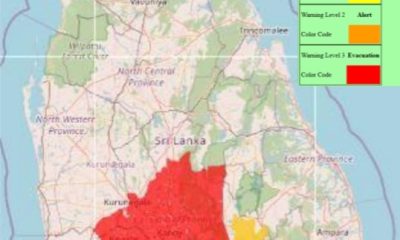
 News5 days ago
News5 days agoLevel III landslide early warning continue to be in force in the districts of Kandy, Kegalle, Kurunegala and Matale
-
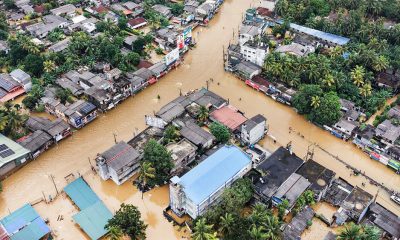
 Features7 days ago
Features7 days agoDitwah: An unusual cyclone
-
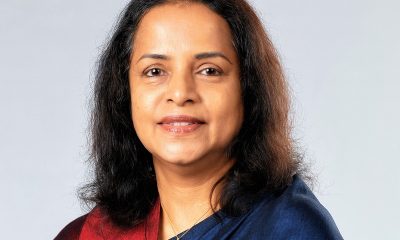
 Business3 days ago
Business3 days agoLOLC Finance Factoring powers business growth
-

 News3 days ago
News3 days agoCPC delegation meets JVP for talks on disaster response
-
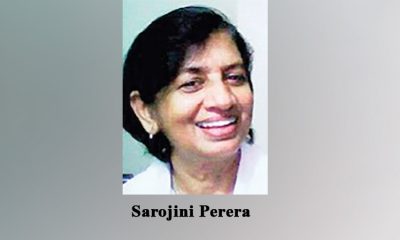
 News3 days ago
News3 days agoA 6th Year Accolade: The Eternal Opulence of My Fair Lady
-

 News20 hours ago
News20 hours agoRising water level in Malwathu Oya triggers alert in Thanthirimale

